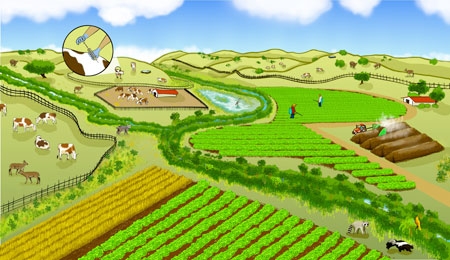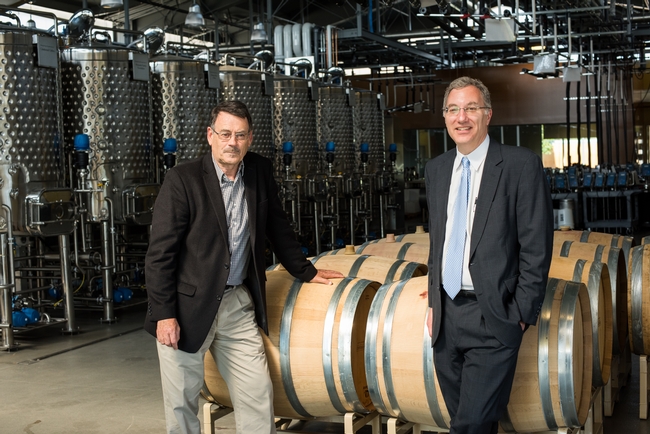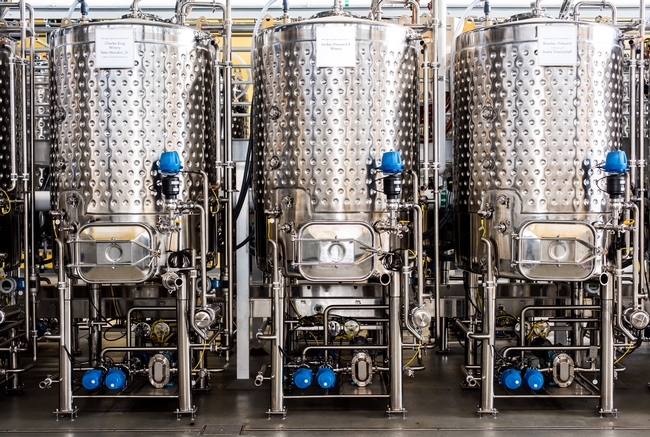UC Food and Agriculture Blogs
Clearing habitat around crops fails to reduce pathogens
The findings, reported today (Aug. 10), in the journal Proceedings of the National Academy of Sciences, call into question the effectiveness of removing non-crop vegetation as a way to reduce field contamination of fresh produce by disease-causing pathogens. This practice led to extensive loss of habitat in a region that is globally important for food production and natural resources.
The practice was implemented largely in response to a 2006 outbreak of pathogenic E. coli in packaged spinach that killed three people and sickened hundreds of others in the United States. That outbreak was traced to a farm in California's Central Coast, a region that supplies more than 70 percent of the country's salad vegetables. The disease-causing E. coli strain was found throughout the farm environment — including in the feces of nearby cattle and wild pigs — but the cause of the outbreak has never been officially determined.
"Wildlife took much of the blame for that outbreak, even though rates of E. coli in wildlife are generally very low," said study lead author Daniel Karp, a NatureNet postdoctoral research fellow in UC Berkeley's Department of Environmental Science, Policy and Management and The Nature Conservancy. "Now, growers are pressured by buyers to implement practices meant to discourage wildlife from approaching fields of produce. This includes clearing bushes, plants and trees that might serve as habitat or food sources for wild animals. Our study found that this practice has not led to the reductions in E. coli and Salmonella that people were hoping for."
Instead, the study authors noted that the presence of diverse habitats bordering food crops can actually provide a number of agricultural benefits.
"There is strong evidence that natural habitats surrounding crop fields encourage wild bee populations and help the production of pollinated food crops," said study senior author Claire Kremen, a UC Berkeley professor of environmental science, policy and management. "There have also been studies that suggest that a landscape with diverse plant life can filter out agrichemical runoff and even bacteria. Changing this dynamic shouldn't be taken lightly."
‘No reason to continue' habitat removal
The researchers analyzed about 250,000 tests of produce, irrigation waters and rodents conducted by industry and academics from 2007 through 2013. The tests were conducted on samples from 295 farms in the United States, Mexico and Chile, and targeted the presence of pathogenic E. coli, Salmonella and generic strains of E. coli. The researchers combined the test data with a fine-scale land-use map to identify characteristics of the landscape surrounding the agricultural fields.
The researchers found that the removal of riparian or other vegetation did not result in lower detection of pathogens in produce, water or rodents. Overall, the prevalence of pathogenic E. coli in leafy green vegetables had increased since the outbreak, even as growers removed non-crop flora. In fact, the growers who removed the most vegetation experienced the greatest increase in pathogenic E. coli and Salmonella in their vegetables over time.
"Clearing surrounding vegetation is a costly, labor-intensive practice that threatens wildlife habitat," said Karp. "Since it does not improve food safety, there is no reason to continue this practice."
The study did find, however, that the likelihood of detecting pathogenic E. coli was greater when fields were within 1.5 kilometers of grazeable land than when they were farther away.
"It is unclear whether it was the cattle or wildlife grazing on those lands that were responsible for the elevated pathogen levels, but there are a number of ways that farming and ranching can co-exist in a diversified system," said Karp.
Some suggestions include:
Leaving strips of vegetation between the grazed areas and fresh produce areas
Fencing off upstream waterways from cattle to prevent waste from going downstream
Planting crops that are usually cooked before being eaten – such as corn, artichokes and wheat – between fresh produce fields and grazeable lands
Reforming farming practices
After the 2006 E. coli outbreak in spinach, California's agricultural industry implemented a voluntary certification program called the Leafy Green Products Handler Marketing Agreement. At the federal level, in 2011 President Obama signed the Food Safety Modernization Act, considered one of the most sweeping reforms in farming practices in decades. Both efforts shift the focus to preventing rather than responding to outbreaks.
Notably, neither the federal law nor the state program calls for the removal of wildlife habitat surrounding crops, but private buyers, keen on retaining consumer confidence in their products, may still require growers to take steps that go beyond government regulations.
"The real worry for me is that federal law will be interpreted as the floor rather than the ceiling of what farmers should do," said Karp. "There is this misguided idea that agricultural fields should be a sanitized, sterilized environment, like a hospital, but nature doesn't work that way."
Other co-authors of the study are Sasha Gennet, senior scientist at The Nature Conservancy; Christopher Kilonzo, Melissa Partyka and Edward Atwill, director of Veterinary Medicine Extension at UC Davis; and Nicolas Chaumont at Stanford University.
The UC Berkeley Center for Diversified Farming Systems, Berkeley Food Institute, The Nature Conservancy NatureNet Fellowship, and The Nature Conservancy of California helped support this research.
RELATED INFORMATION
Farm practices for food safety: an emerging threat to floodplain and riparian ecosystem
Changing how we farm can save evolutionary diversity, study suggests
Wild bees get boost from diverse, organic crops
Diversified Farming Systems for Ecosystem Services
Wild pollinators worth up to $2.4 billion to farmers, study finds
Brown marmorated stink bug found in Stanislaus County
The brown marmorated stink bug (BMSB) has made its way to Stanislaus County, reported John Holland in the Modesto Bee. The invasive pest, introduced into the U.S. from Asia, has also been detected in San Joaquin, Sacramento, Yolo, Sutter, Butte, Santa...
Preventing Lawn Insects
[From the July 2015 issue of the UC IPM Retail IPM Newsletter] Insect pests, though actually quite rare in well-managed lawns and turf, can sometimes jeopardize a flawless appearance, potentially sending people running to their local nursery or garden...
How do you know your food is local?
I would imagine you have noticed the new hot trend in the food world: local, local, Local. Everything is “local” now. I am a big fan of buying local, and I am very happy that supporting local farmers and ranchers is all the rage...
Helping winemakers sustainably produce premium wine
Ten large, shiny tanks stand near the Robert Mondavi Institute for Wine and Food Science at UC Davis, holding more than a year of rainwater and the key to processing food and drink during a drought. The water tanks, and the teaching-and-research winery they support, are showing students and winemakers throughout the world how to reduce processing costs, improve wine quality, and protect the planet's dwindling natural resources.
“It's about self-sufficiency,” says Roger Boulton, UC Davis professor of enology and chemical engineering. “We're demonstrating how you can operate a winery, brewery, or any food processing plant with the water that falls and the sun that shines on your roof.”
The work is the latest in more than a century of trail-blazing viticulture and enology science at UC Davis. UC Davis researchers are working with Cooperative Extension specialists and farm advisors with UC Agriculture and Natural Resources to help winemakers and grape growers sustainably produce premium wine.
Water is critical to winemakers in drought-stricken California and beyond. Grapes aren't a very thirsty crop to grow, but keeping fermentors clean is another story.
A typical winery uses four to six gallons of water after the grapes are harvested to produce one gallon of wine, and most of that water is used to wash equipment. Boulton and David Block, chair of the UC Davis Department of Viticulture and Enology, are developing self-cleaning fermentors capable of recycling 90 percent of that water. The goal: affordable technology and alternative practices that use less than one gallon of water to produce one gallon of wine.
Winemakers currently remove sticky, fermented, grape residue from tanks with water and elbow grease. Clean-in-place technology replaces hand-cleaning with an automated system that sprays tanks with diluted solutions of potassium hydroxide and potassium bisulfate.
“The dairy industry has used clean-in-place technology since the 1960s and the pharmaceutical industry since the 1990s,” says Block, a chemical engineer and enologist who helped the pharmaceutical industry manage clean-in-place technology before coming to UC Davis in 2008. “It's a little different with dairy and pharmaceuticals, where poor sanitation can kill you, but the concept is similar.”
So the water tanks near the Robert Mondavi Institute have two functions, to store water captured during the wet season to use during the dry season when it's needed most, and to filter and purify the water as it's used and reused to clean fermentors.
“We will filter and reuse that water at least five times, hopefully one day up to 10 times,” Boulton says. “It's not waste water. It has no phosphates, no nitrates, and no chlorine. Clean-in-place technology represents a huge potential for water and labor savings.”
Industry is starting to notice.
“Clean-in-place technology is very attractive to us,” says Ashley Heisey, director of winemaking at Long Meadow Ranch in Rutherford and a UC Davis viticulture and enology graduate. “Water is such a critical issue. Long Meadow Ranch owners Ted, Chris, and Laddie Hall built our facilities with great concern for the environment, and thanks to UC Davis, we can take it one step further.”
In Sacramento, grocer Darrell Corti from Corti Brothers Market says where UC Davis leads, winemakers will eventually follow.
“What we know about grape-growing and winemaking is primarily due to the work they do at UC Davis,” Corti says.
A longer version of this story is in the magazine Edible Sacramento.





